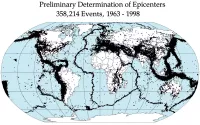Sumo is a full-contact wrestling sport where wrestlers (rikishi) try to force their opponent out of a circular ring (dohyō) or make them touch the ground with anything other than their feet. The primary objective is to use various grappling techniques to unbalance and displace the opponent, leading to a victory when one of these conditions is met. It is a traditional Japanese sport with a rich history.
1909: List of Upper Divisions Champions
Refer to the lists of top division champions and second division champions for the list of upper division champions since 1909.
1914: First Brazilian Sumo Tournament
In 1914, the first Brazilian sumo tournament was held.
1923: Great Kantō earthquake
The 2018 film 'The Chrysanthemum and the Guillotine' depicts female sumo wrestlers at the time of civil unrest following the 1923 Great Kantō earthquake.
December 1925: Japan Sumo Association Reunited
On December 28, 1925, the Japan Sumo Association reunited and increased the number of annual tournaments from two to four.
1949: Extension of Tournament Length
In 1949, the length of sumo tournaments was extended from ten to fifteen days.
1958: Increase in Annual Tournaments
In 1958, the Japan Sumo Association increased the number of annual tournaments from four to six.
1969: Average Weight Increase
In 1969, the average weight of top division wrestlers was 125 kilograms (276 lb).
1973: First Collegiate Yokozuna
In 1973, Hiroshi Wajima became the first, and remains the only, wrestler with a collegiate background to attain the rank of yokozuna.
September 1974: Extremely Rare Draw
In September 1974, an extremely rare hikiwake (draw) occurred, marking the last such draw in sumo wrestling.
1985: National Sumo Federation Existed
As early as 1985, a national Sumo Federation existed in the UK.
1985: New Kokugikan Venue
In 1985, the Kokugikan moved to a newly built venue at Ryōgoku.
1991: Average Weight Increase
By 1991, the average weight of top division wrestlers had increased to over 150 kilograms (330 lb).
1991: Exhibition Tournament in London
In 1991, an exhibition sumo tournament was held at the Royal Albert Hall in London, which Hokutoumi Nobuyoshi won.
1992: Establishment of IFS
In 1992, the International Sumo Federation (IFS) was established to promote the sport's development worldwide.
1994: Minimum Height Requirement Introduced
In 1994, the Japanese Sumo Association required that all sumo wrestlers be a minimum 173 cm (5 ft 8 in) in height, leading to cosmetic surgeries by aspiring wrestlers.
1998: Absence of Japanese Yokozuna
From 1998 until 2017, no Japanese wrestler had been named yokozuna, highlighting the dominance of foreign-born wrestlers in sumo's highest ranks.
November 1999: Increasing Collegiate Background
In November 1999, the International Herald Tribune reported that more than a third of the wrestlers in the top two divisions had a university degree.
2001: Sumo at the World Games
From 2001 until 2022, Sumo was featured in the World Games.
2007: Training Stables and Wrestlers
In 2007, 43 training stables hosted 660 wrestlers in professional sumo.
2007: US Sumo Open
In 2007, the US Sumo Open was held in the Los Angeles Convention Center, attracting an audience of 3,000.
2008: Controversies and Scandals
In 2008, the sumo world was rocked by high-profile controversies and scandals, which negatively affected its reputation and ticket sales, and impacted its ability to attract new recruits.
January 2009: Foreign-Born Wrestler Promotion
In the 10 years since January 2009, five of the nine wrestlers promoted to ōzeki were foreign-born, signaling a shift in the composition of top-ranked sumo wrestlers.
2010: Sumo at World Combat Games
Since their inception in 2010, Sumo has been featured at the World Combat Games.
2016: Rebound in Popularity
By 2016, sumo's popularity and general attendance had rebounded due to the presence of multiple yokozuna (grand champions) and other high-profile wrestlers gaining public attention.
2017: Promotion of Kisenosato Yutaka
In 2017, Kisenosato Yutaka became the first Japanese wrestler to be promoted to yokozuna since 1998, ending a period of foreign dominance in the highest rank.
2018: Monthly Salary Figures
As of 2018, salary figures for the top two divisions were available.
2018: Film Depicting Female Sumo
In 2018, the film "The Chrysanthemum and the Guillotine" was released, depicting female sumo wrestlers at the time of civil unrest following the 1923 Great Kantō earthquake.
January 2019: Record Average Weight
As of January 2019, the average weight of top division wrestlers reached a record 166 kilograms (366 lb).
2019: Cost of Sponsorship
As of 2019, a single sumo sponsorship cost ¥70,000, with ¥60,000 going to the winner and ¥10,000 deducted by the Japan Sumo Association.
2019: Height and Weight Requirements
In 2019, The Japan Times reported the minimum height requirement was 167 cm (5 ft 6 in), and the weight requirement was 67 kg (148 lb) for sumo wrestlers.
2022: Removal From World Games
In 2022, sumo was removed from future World Games programs due to poor sportsmanship and organization.
2023: Height and weight requirements loosened
In 2023, the Sumo Association loosened the height and weight requirements, announcing that prospective recruits not meeting the minimums could still enter sumo by passing a physical fitness exam.
October 17, 2025: Return Appearance in London
A return appearance is currently scheduled for October 17, 2025 in London.
2025: British Sumo Governing Body
In 2025 BritishSumo became the recognised national governing body.
Mentioned in this timeline
Japan is an East Asian island country situated in the...

Los Angeles is the most populous city in California and...

An earthquake is the shaking of the Earth's surface caused...

Tokyo officially Tokyo Metropolis is the capital and most populous...

Sport is a diverse realm of physical activities ranging from...
Time is the continuous irreversible progression of existence from past...
Trending

58 minutes ago Joe Walsh & All-Stars Rock Hometown Tribute to Vets with 'Wichita Lineman' Duet
58 minutes ago Tesla Approved to Launch Autonomous Rideshare Service in Arizona: A New Era
58 minutes ago Dylan O'Brien Stars in Sam Raimi's Outrageous Horror Comeback, 'Send Help'
2 hours ago Idris Elba's squat routine and the dangers of looksmaxxing for young men.
2 hours ago Jamaree Bouyea gets another NBA chance: Suns sign former Bucks guard to contract.

2 hours ago Joe Rogan's Podcast Tops Apple Charts as most Popular Show in 2025
Popular

XXXTentacion born Jahseh Dwayne Ricardo Onfroy was a controversial yet...

Cristiano Ronaldo often nicknamed CR is a Portuguese professional footballer...

Candace Owens is an American conservative political commentator and author...

William Franklin Graham III commonly known as Franklin Graham is...

Bill Clinton the nd U S President - served as...

Michelle Obama is an American attorney author and former First...